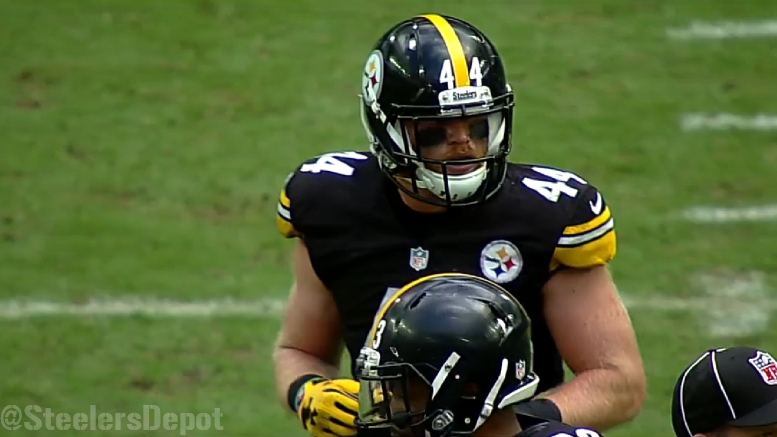It’s said a draft class can’t be fully graded until at least three years after the picks are made. That’s why after submitting grades for every Pittsburgh Steelers pick made in 2021, I began going back through and grading previous Steeler draft classes beginning with 2018. Today continues the third class in that exercise, with the Steelers’ second of two seventh-round picks, and final overall pick, in the 2016 NFL Draft: Tyler Matakevich, a linebacker from Temple.
This exercise follows the six viewpoints (listed below) for examining and re-grading a pick. Each of the first five viewpoints gets examined and assigned a letter grade, before taking that analysis and combining it into a final letter grade. Those five viewpoints comprise much of what goes into the draft grades consumed by so many every year after the draft.
Steelers’ Career: What did the player contribute to the team that drafted him?
NFL Career: Did the player make the pick look better in hindsight after leaving Pittsburgh?
Pick Value: Did the player outperform his draft slot? Did he fail to live up to the pick used on him?
Positional Value: Was the player the best player remaining at his specific position in the draft?
Other Options: Did any players go during the next round that were better selections?
Overall Grade: A final mark to denote whether the selection was an overall positive one, or one better spent elsewhere.
Each factor in a retrospective doesn’t apply evenly to every pick made; consider the grades weighted. For example, to return a high grade in pick value, a first-round pick should have a long and impactful career, while a later-round pick needs only a couple seasons as a back-up or modest contributor to be worth the selection used on him.
Some factors are universal, though. Whether picked first overall or 259th, there will always be other options on the board to compare the player to, and steals and reaches can come from any place in the draft.
Round 7, Pick 25: Tyler Matakevich, LB, Temple
STEELERS CAREER: B+
When the Steelers drafted Matakevich, Ryan Shazier and Lawrence Timmons were entrenched as the team’s starting duo at inside linebacker. But immediately, Matakevich looked like a superstar on special teams, and that is how the Temple product carved out an NFL career for himself.
Immediately taking on a major role on Pittsburgh’s special teams unit, Matakevich began his career with 270 special teams snaps as a rookie, and increased that number each of his four years in Pittsburgh. His snaps peaked with 340 in his final season, and he never played fewer than 60 percent of the team’s special teams snaps in a season.
Matakevich had at least 10 special teams tackles each of his four seasons with the Steelers. In total, he recorded 53 of them between 2016-2019. In his final year with the Steelers, his 16 special teams tackles tied him for the NFL lead. His 13 tackles in 2016 and 14 in 2017 ranked him ninth in the league each of those seasons.
Matakevich never captained the Steelers’ special teams, but was a permanent leader of the unit. Nearly 70 percent of his 77 tackles with the team came on those snaps, and he played eight times as many reps on special teams (1,208) in Pittsburgh as he did on defense (149). He was invaluable to the team during his time on the roster, even if it was never with the actual defense.
NFL CAREER: B+
Leaving Pittsburgh as a free agent following the 2019 season, Matakevich has not changed a bit, and so neither does this grade. Signing a two-year deal worth $9 million with the Buffalo Bills, he remained the same star special teams player that he was in Pittsburgh. Matakevich played 343 snaps with the Bills in 2020, a new career high, and had 10 special teams tackles for the fifth consecutive season to begin his career. He also played a career-high 72 snaps on defense, and finished the season with 23 total tackles to match his season-best from Pittsburgh.
Matakevich signed a one-year extension with Buffalo this offseason, giving him another two years with the team if he lasts the length of his contract. He remains one of the best special teams players in football, and may earn himself his first captaincy during that time.
PICK VALUE: A
A player picked seven spots before Mr. Irrelevant carries the same expectations as a UDFA. Matakevich, even without becoming a defensive contributor, has exceeded those considerably. Every team needs at least one special teams ace. The player that can help lead the unit, make plays, and avoid surrendering any major returns. Matakevich is that player, first with the Steelers and now with the Bills. He earned a cap hit north of $3 million in Buffalo specifically to play special teams for a reason. Pittsburgh identified serious value with its final selection in 2016, and filled an under appreciated role with the pick.
POSITIONAL VALUE: B
Only two linebackers went after Matakevich in the remaining few picks of the 2016 draft. For all his college production, Scooby Wright III (250th, Cleveland) never stuck in the league. Joe Walker (251st, Philadelphia) did, and had 65 tackles starting most of 2019 for Arizona. Matakevich is the best option of those three, and it’s not very close.
Picked so late, this exercise lets me compare him to the remaining linebackers who signed as UDFAs. Three stuck out as NFL contributors. Cory Littleton is the best one, making the Pro Bowl in 2018 and posting two seasons of over 120 tackles with the L.A. Rams before signing a contract for over $11 million a season with Las Vegas. Patrick Onwuasor looked to be on a similar trajectory with Baltimore after starting two of his first three seasons there, but fell out of a starting spot and spent last year injured with the New York Jets. James Burgess has also started two seasons, one with Cleveland and one with the Jets, with at least 75 tackles both years.
Those three all became central players on their teams’ defenses, no small accomplishment for a UDFA. Matakevich’s consistency counts for something, though. He has held a consistently valuable role that two of three main UDFAs haven’t. Littleton easily wins in a re-draft. The rest open it up for some debate.
OTHER OPTIONS: B
As a quick reminder in how I designed these retrospectives, seventh-round picks get graded against the entire UDFA class at their position specifically, but it isn’t fair to compare them to the considerably larger pool of UDFAs across every position. That means this grade carries less value for Matakevich compared to the Steelers’ other picks, because only seven players went between he and the end of the draft.
Of those seven, two never appeared in an NFL game, and a third appeared in just one. Walker, referenced above, is one of the three still active in the NFL. So is Mr. Irrelevant Kalan Reed, though as a free agent. The other is Austin Blythe, mentioned in retrospectives for both Travis Feeney and Demarcus Ayers. Taken two picks after Matakevich by the L.A. Rams, Blythe has started three consecutive seasons for the Rams at center and guard.
Now on a modest one-year contract with Kansas City, Blythe is competing to start at center for the reigning two-time AFC champions. He is the lone player taken after Matakevich who offers superior value. But with only seven total players taken later, this section does not carry the impact it does with players for whom more selections exist to compare them to.
OVERALL GRADE: A
Picking this late in any draft, getting a player who can stick on the main roster for more than a couple seasons is already a job well done. Finding a four-year contributor is a home run, even if those contributions come on special teams and not on offense or defense. Matakevich was a star for the Steelers’ special teams unit, one of the best players that has suited up for it in the last two decades. He annually appeared among the league leaders in tackles there, and proved his value so much that another team offered a good amount of money for a special teams specialist.
Matakevich didn’t carry the impact that Javon Hargrave did for the Steelers. But in a weaker overall class for the team, Matakevich is right below Hargrave as one of the Steelers’ best picks. He returned plenty of value on a selection at the tail end of the draft, in an underheralded but essential role.








